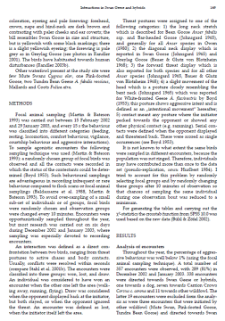- Wyszukaj w całym Repozytorium
- Piśmiennictwo i mapy
- Archeologia
- Baza Młynów
- Nauki przyrodnicze
Wyszukiwanie zaawansowane
Wyszukiwanie zaawansowane
Wyszukiwanie zaawansowane
Wyszukiwanie zaawansowane
Wyszukiwanie zaawansowane

Obiekt
Tytuł: Nest re-use by blackbirds - the way for safe breeding?
Twórca:
Wysocki, Dariusz (1961– ) ; Polska Akademia Nauk. Muzeum i Instytut Zoologii
Data wydania/powstania:
Typ zasobu:
Inny tytuł:
Acta Ornithologica, vol. 39, no. 2 ; Czy ponowne użytkowanie gniazd przez kosy może być sposobem unikania drapieżników?
Współtwórca:
Museum and Institute of Zoology, Polish Academy of Sciences
Wydawca:
Miejsce wydania:
Opis:
Bibliogr. s. 168 ; S. [164]-168 ; 27 cm ; Streszcz. pol. Nazwy taksonów także w jęz. łac.
Typ obiektu:
Abstrakt:
The biology of individually colour-ringed European Blackbirds inhabiting two city parks in Szczecin (NW Poland) was studied in 1997–2003. In each park one to three observers watched the behaviour of Blackbirds every other day from dawn till afternoon (6–8 h a day); in this way almost all of their nests were discovered. 35 cases were recorded where pairs re-used their own nests, as well as two cases where the nest of another Blackbird pair and one Fieldfare nest were re-used. In 33 out of 81 cases observed, the re-use occurred after the brood had been successfully reared, while in two cases out of 378, female Blackbirds initiated the second breeding attempt in the same nest after the loss of the first one. The re-used nests were better concealed (80 ± 19% and 69 ± 18%, respectively) and had been built at greater heights than those abandoned after breeding (9.0 ± 5.0 m and 6.5 ± 4.2 m, respectively). No shortening of the interval between successive clutches was noted in the case of nest re-use (re-used nests 36.8 ± 4.9 days, newly-built nests 37.7 ± 8.0). The more and more frequent re-use of nests where breeding had been successful, their better concealment and higher sites, and also the lack of any differences in the intervals between successive clutches of pairs occupying old nests and those building new ones before the next breeding attempt, suggest that in the investigated population the basic reason for nest re-use was the insufficient number of safe nesting sites.
Czasopismo/Seria/cykl:
Tom:
Zeszyt:
Strona pocz.:
Strona końc.:
Szczegółowy typ zasobu:
Format:
Identyfikator zasobu:
Źródło:
MiIZ PAN, sygn. patrz sygn. czas. P.257-39-2 ; MiIZ PAN, sygn. patrz sygn. czas. P.4568-39-2 ; kliknij tutaj, żeby przejść
Język:
Prawa:
Prawa zastrzeżone - dostęp nieograniczony
Zasady wykorzystania:
Digitalizacja:
Muzeum i Instytut Zoologii Polskiej Akademii Nauk
Lokalizacja oryginału:
Biblioteka Muzeum i Instytutu Zoologii PAN
Dostęp:
Kolekcje, do których przypisany jest obiekt:
- Repozytorium Cyfrowe Instytutów Naukowych > Kolekcje Partnerów > Muzeum i Instytut Zoologii PAN > Czasopisma
- Repozytorium Cyfrowe Instytutów Naukowych > Kolekcje Partnerów > Muzeum i Instytut Zoologii PAN > Wydawnictwa MiIZ PAN > Acta Ornithologica
- Repozytorium Cyfrowe Instytutów Naukowych > Piśmiennictwo > Czasopisma/Artykuły
Data ostatniej modyfikacji:
2 paź 2020
Data dodania obiektu:
28 lip 2015
Liczba pobrań / odtworzeń:
52
Wszystkie dostępne wersje tego obiektu:
https://rcin.org.pl./publication/49789
Wyświetl opis w formacie RDF:
Wyświetl opis w formacie RDFa:
Wyświetl opis w formacie OAI-PMH:
| Nazwa wydania | Data |
|---|---|
| Nest re-use by blackbirds - the way for safe breeding? / Wysocki D. | 2 paź 2020 |
Obiekty Podobne
Wysocki, Dariusz (1961– ) Walasz, Kazimierz (1952– ) Polska Akademia Nauk. Muzeum i Instytut Zoologii
Iwan, Dariusz Polska Akademia Nauk. Muzeum i Instytut Zoologii
Warchałowski Andrzej Polska Akademia Nauk. Muzeum i Instytut Zoologii
Burakowski, Bolesław Polska Akademia Nauk. Muzeum i Instytut Zoologii
Tomaszewska, K. Wioletta Polska Akademia Nauk. Muzeum i Instytut Zoologii
Hetmański, Tomasz Polska Akademia Nauk. Muzeum i Instytut Zoologii
Rutkowski, Robert Polska Akademia Nauk. Muzeum i Instytut Zoologii.
Milne, Rebecca J Polska Akademia Nauk. Muzeum i Instytut Zoologii

 INSTYTUT ARCHEOLOGII I ETNOLOGII POLSKIEJ AKADEMII NAUK
INSTYTUT ARCHEOLOGII I ETNOLOGII POLSKIEJ AKADEMII NAUK
 INSTYTUT BADAŃ LITERACKICH POLSKIEJ AKADEMII NAUK
INSTYTUT BADAŃ LITERACKICH POLSKIEJ AKADEMII NAUK
 INSTYTUT BADAWCZY LEŚNICTWA
INSTYTUT BADAWCZY LEŚNICTWA
 INSTYTUT BIOLOGII DOŚWIADCZALNEJ IM. MARCELEGO NENCKIEGO POLSKIEJ AKADEMII NAUK
INSTYTUT BIOLOGII DOŚWIADCZALNEJ IM. MARCELEGO NENCKIEGO POLSKIEJ AKADEMII NAUK
 INSTYTUT BIOLOGII SSAKÓW POLSKIEJ AKADEMII NAUK
INSTYTUT BIOLOGII SSAKÓW POLSKIEJ AKADEMII NAUK
 INSTYTUT CHEMII FIZYCZNEJ PAN
INSTYTUT CHEMII FIZYCZNEJ PAN
 INSTYTUT CHEMII ORGANICZNEJ PAN
INSTYTUT CHEMII ORGANICZNEJ PAN
 INSTYTUT FILOZOFII I SOCJOLOGII PAN
INSTYTUT FILOZOFII I SOCJOLOGII PAN
 INSTYTUT GEOGRAFII I PRZESTRZENNEGO ZAGOSPODAROWANIA PAN
INSTYTUT GEOGRAFII I PRZESTRZENNEGO ZAGOSPODAROWANIA PAN
 INSTYTUT HISTORII im. TADEUSZA MANTEUFFLA POLSKIEJ AKADEMII NAUK
INSTYTUT HISTORII im. TADEUSZA MANTEUFFLA POLSKIEJ AKADEMII NAUK
 INSTYTUT JĘZYKA POLSKIEGO POLSKIEJ AKADEMII NAUK
INSTYTUT JĘZYKA POLSKIEGO POLSKIEJ AKADEMII NAUK
 INSTYTUT MATEMATYCZNY PAN
INSTYTUT MATEMATYCZNY PAN
 INSTYTUT MEDYCYNY DOŚWIADCZALNEJ I KLINICZNEJ IM.MIROSŁAWA MOSSAKOWSKIEGO POLSKIEJ AKADEMII NAUK
INSTYTUT MEDYCYNY DOŚWIADCZALNEJ I KLINICZNEJ IM.MIROSŁAWA MOSSAKOWSKIEGO POLSKIEJ AKADEMII NAUK
 INSTYTUT PODSTAWOWYCH PROBLEMÓW TECHNIKI PAN
INSTYTUT PODSTAWOWYCH PROBLEMÓW TECHNIKI PAN
 INSTYTUT SLAWISTYKI PAN
INSTYTUT SLAWISTYKI PAN
 SIEĆ BADAWCZA ŁUKASIEWICZ - INSTYTUT TECHNOLOGII MATERIAŁÓW ELEKTRONICZNYCH
SIEĆ BADAWCZA ŁUKASIEWICZ - INSTYTUT TECHNOLOGII MATERIAŁÓW ELEKTRONICZNYCH
 MUZEUM I INSTYTUT ZOOLOGII POLSKIEJ AKADEMII NAUK
MUZEUM I INSTYTUT ZOOLOGII POLSKIEJ AKADEMII NAUK
 INSTYTUT BADAŃ SYSTEMOWYCH PAN
INSTYTUT BADAŃ SYSTEMOWYCH PAN
 INSTYTUT BOTANIKI IM. WŁADYSŁAWA SZAFERA POLSKIEJ AKADEMII NAUK
INSTYTUT BOTANIKI IM. WŁADYSŁAWA SZAFERA POLSKIEJ AKADEMII NAUK


































